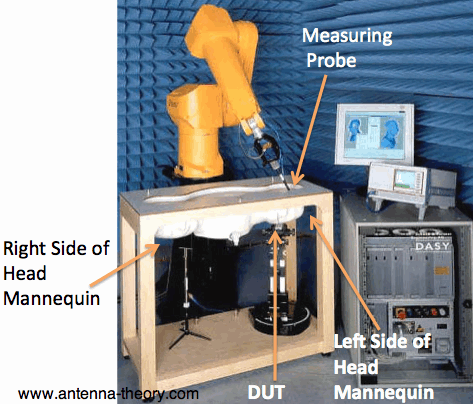Specific Absorption Rate (SAR)
Specific Absorption Rate (or SAR) is a measure of how transmitted RF energy is absorbed by human tissue.
SAR is a function of the electrical conductivity
( , measured in Siemens/meter), the induced E-field from the radiated energy
(measured in Volts/meter), and the mass density of the tissue
( , measured in Siemens/meter), the induced E-field from the radiated energy
(measured in Volts/meter), and the mass density of the tissue
( , in kg/cubic-meter). The SAR is calculated by averaging (or integrating) over
a specific volume (typically a 1 gram or 10 gram area): , in kg/cubic-meter). The SAR is calculated by averaging (or integrating) over
a specific volume (typically a 1 gram or 10 gram area):
 [1] [1]The units of SAR are W/kg, or equivalently, mW/g. The SAR limit in the US for mobile phones is 1.6 W/kg, averaged over 1 gram of tissue. In Europe, the SAR limit is 2.0 W/kg averaged over 10 grams of tissue. It is typically harder to achieve the US specification than the Europe spec, so if the phone meets the US spec it will typically also meet the European spec.
Measuring SARTo obtain official SAR measurements, the DASY system by SPEAG is used. This is shown in Figure 1:
 Figure 1. The DASY SAR Measurement System. In Figure 1, there is a hollow tub that the yellow robot moves the measuring probe into. The tub is formed in standardized shapes, which replicate the shape of the human head. The tub that the probe is measuring for Figure 1 simulates the left side of the human head. The DUT is the device-under-test (the mobile phone) is placed directly on the edge of the tub, and transmits at maximum power continuously. The probe is moved through the head region by the yellow robot arm, performing the averaging in Equation [1]. To simulate the conductivity and density correctly, the tub is filled with a fluid that has similar properties to human tissue. The fluids are frequency-dependent, so a standardized fluid for a measurement at 1800 MHz will be different from the correct fluid for measuring SAR at 900 MHz. The SAR must be measured on both the left and right side of the head as shown in Figure 1. Even though geometrically the measurements are fairly similar, the results can be very different due to the chaotic nature of the near field. The SAR values quoted for a mobile phone are the highest value of SAR measured for any frequency the phone operates in, from both the left and right side of the head.
Lowering SARSAR is critical to antenna design, because if the SAR is too high the antenna must be changed. Typically, if the SAR is too high the transmit power is lowered, which directly yields lower SAR. However, since there are minimum transmit power specifications for mobile devices, the SAR cannot be dropped indefinitely. As a result, the antenna positioning is critical. The antennas for mobile phones are typically on the bottom of the phone, to keep the radiating part of the phone as far as possible from the brain region. Other methods for dropping the SAR include impedance matching changes and parasitic resonators which will disturb the antenna's radiation pattern (hopefully lowering SAR).
|
Antennas (Home)